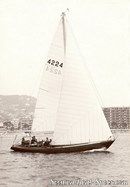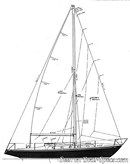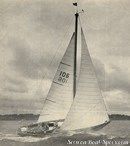Swan 36
Sailboat specifications
The Swan 36 is a 35’10” (10.91m) cruiser-racer sailboat designed by Sparkman & Stephens (United States). She was built between 1967 and 1970 by Nautor's Swan (Finland).
Swan 36's main features
- Model
- Swan 36
- Hull type
- Monohull
- Category
- Cruiser-racer sailboat
- Sailboat builder
- Sailboat designer
- Country
- Finland
- Construction
- GRP (glass reinforced polyester):
- Hull: Single skin fiberglass polyester
- Deck: Sandwich fiberglass polyester - Number of hulls built
- About 90
- First built hull
- 1967
- Last built hull
- 1970
- Appendages
- Keel : fin without bulb
- Helm
- Single tiller
- Rudder
- Single spade rudder
- Unsinkable
- No
- Trailerable
- No
- Former French navigation category
- 1
- Standard public price ex. VAT (indicative only)
- N/A €
Swan 36's main dimensions
- Hull length
- 35’ 10”10.91 m
- Waterline length
- 25’ 6”7.77 m
- Beam (width)
- 9’ 7”2.94 m
- Draft
- 6’ 2”1.9 m
- Light displacement (MLC)
- 15432 lb7000 kg
- Ballast weight
- 7937 lb3600 kg
- Ballast type
- Lead
Swan 36's rig and sails
- Upwind sail area
- 681 ft²63.3 m²
- Downwind sail area
- 1316 ft²122.3 m²
- Mainsail area
- 229 ft²21.3 m²
- Genoa area
- 452 ft²42 m²
- Symmetric spinnaker area
- 1087 ft²101 m²
- IiFore triangle height (from mast foot to fore stay top attachment)
- 42’ 11”13.07 m
- JiFore triangle base (from mast foot to bottom of forestay)
- 13’ 8”4.17 m
- PiMainsail hoist measurement (from tack to head)
- 38’ 1”11.6 m
- EiMainsail foot measurement (from tack to clew)
- 13’ 1”3.99 m
- Rigging type
- Sloop Marconi masthead
- Mast configuration
- Keel stepped mast
- Rotating spars
- No
- Number of levels of spreaders
- 1
- Spreaders angle
- 0 °
- Spars construction
- Aluminum spars
- Standing rigging
- Continuous
Swan 36's performances
- HN (French rating)iHN or "Handicap Nationale" is an empirical rating system used in France allowing various monohulls, of different sizes and designs, to race each other fairly. It is particularly suitable for cruiser and cruiser-racer. Therefore, by comparing these values, we can have an indication of the relative speed of 2 boats.
- 18.0
- Upwind sail area to displacementiThe ratio sail area to displacement is obtained by dividing the sail area by the boat's displaced volume to the power two-thirds.
The ratio sail area to displacement can be used to compare the relative sail plan of different sailboats no matter what their size.
Upwind: under 18 the ratio indicates a cruise oriented sailboat with limited performances especially in light wind, while over 25 it indicates a fast sailboat. - 186 ft²/T17.3 m²/T
- Downwind sail area to displacementiThe ratio sail area to displacement is obtained by dividing the sail area by the boat's displaced volume to the power two-thirds.
The ratio sail area to displacement can be used to compare the relative sail plan of different sailboats no matter what their size. - 360 ft²/T33.42 m²/T
- Displacement-length ratio (DLR)iThe Displacement Length Ratio (DLR) is a figure that points out the boat's weight compared to its waterline length. The DLR is obtained by dividing the boat's displacement in tons by the cube of one one-hundredth of the waterline length (in feet).
The DLR can be used to compare the relative mass of different sailboats no matter what their length:
a DLR less than 180 is indicative of a really light sailboat (race boat made for planning), while a DLR greater than 300 is indicative of a heavy cruising sailboat. - 423
- Ballast ratioiThe Ballast ratio is an indicator of stability; it is obtained by dividing the boat's displacement by the mass of the ballast. Since the stability depends also of the hull shapes and the position of the center of gravity, only the boats with similar ballast arrangements and hull shapes should be compared.
The higher the ballast ratio is, the greater is the stability. - 51 %
- Critical hull speediAs a ship moves in the water, it creates standing waves that oppose its movement. This effect increases dramatically the resistance when the boat reaches a speed-length ratio (speed-length ratio is the ratio between the speed in knots and the square root of the waterline length in feet) of about 1.2 (corresponding to a Froude Number of 0.35) . This very sharp rise in resistance, between speed-length ratio of 1.2 to 1.5, is insurmountable for heavy sailboats and so becomes an apparent barrier. This leads to the concept of "hull speed".
The hull speed is obtained by multiplying the square root of the waterline length (in feet) by 1.34. - 6.77 knots
Swan 36's auxiliary engine
- Engine(s)
- 1 inboard engine
- Engine(s) power
- 15 HP
- Fuel type
- Diesel
- Fuel tank capacity
- 13.2 gal50 liters
Swan 36's accommodations and layout
- Cockpit
- Closed aft cockpit
- Cabin(s)
- 1
- Berth(s) (min./max.)
- 4 / 7
- Head(s)
- 1
- Freshwater tank capacity
- 44.9 gal170 liters
- Maximum headroom
- 6’ 2”1.88 m



Nautor's Swan Swan 36 sailplan - - 2/5
Picture extracted from the commercial documentation © Nautor's Swan
Picture extracted from the commercial documentation © Nautor's Swan


Nautor's Swan Swan 36 layout - - 3/5
Picture extracted from the commercial documentation © Nautor's Swan
Picture extracted from the commercial documentation © Nautor's Swan


Nautor's Swan Swan 36 layout - - 4/5
Picture extracted from the commercial documentation © Nautor's Swan
Picture extracted from the commercial documentation © Nautor's Swan


Nautor's Swan Swan 36 sailing - - 5/5
Picture extracted from the commercial documentation © Nautor's Swan
Picture extracted from the commercial documentation © Nautor's Swan
Similar sailboats that may interest you:
Sailboats
First built hull
Hull length
1966
33’ 5”10.18 m
1974
33’ 6”10.2 m
1991
34’ 4”10.44 m
1983
34’ 10”10.6 m
1978
28’ 1”8.56 m
1971
30’9.14 m
1979
29’ 10”9.07 m
1980
35’ 2”10.72 m
1977
40’ 10”12.44 m
1970
36’ 5”11.08 m
1979
36’ 10”11.23 m
1973
29’ 6”9 m
1967
33’ 1”10.1 m
1999
34’ 1”10.4 m
1972
38’ 8”11.8 m